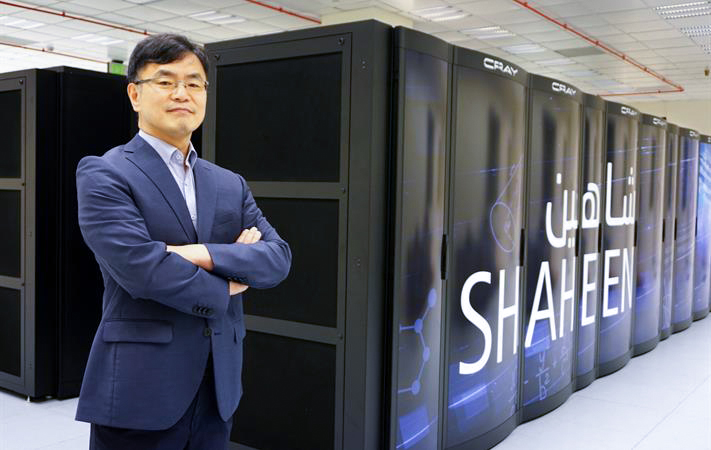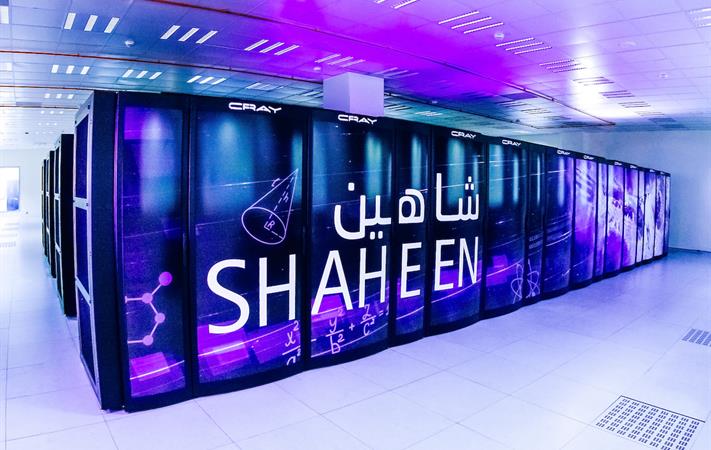Jysoo Lee honored for HPC leadership & contributions

Director of the KAUST Research Computing Core Labs Jysoo Lee. File photo.
Dr. Jysoo Lee, Facilities Director of the Research Computing Core Labs at King Abdullah University of Science and Technology (KAUST) was recently honored as part of SupercomputingAsia (SCA)'s annual conference for leading pioneering initiatives to develop South Korea's HPC community and driving activities that have advanced international cooperation.
Lee received the SCA HPC Leadership/Achievement Award during the SCA22 Awards Ceremony, held on March 2, 2022, at the SupercomputingAsia 2022 (SCA22) hybrid conference in Singapore. Founded in 2017 and co-organized by HPC centres from Australia, Japan, Thailand and Singapore, the SCA Awards ceremony highlights and promotes the achievements of trailblazers having a notable impact on Asia's high-performance computing (HPC) ecosystem. One of three awards, the SCA HPC Leadership/Achievement Award recognizes an outstanding individual with excellence in leadership within the HPC community, particularly for the ASEAN, Asian and Australasian regions.

“The SCA Awards continues to identify and recognize individuals who have made significant achievements in their vision, leadership and contributions to HPC and related technologies. The three SCA22 award winners, indeed, have well-established track records of impactful achievements that have greatly benefitted the HPC communities, both domestically and across the region,” said Prof Lawrence Wong, Chair of the SCA22 Organizing Committee.
Supercomputers improving everyday life
Having worked in the area of HPC for more than 30 years, Lee has made numerous contributions to the establishment and development of high-performance computing in his native South Korea. Among those achievements, he led the effort for the legislation of the “National Supercomputing Promotion Act” to enhance people’s quality of life and the economic development of the nation through the efficient use of supercomputing. He became the founding director-general of NISN (National Institute of Supercomputing and Networking), an organization created to pursue this national objective.
Lee also played an active role in building South Korea's HPC communities by leading the establishment of the Korean Society of Computational Sciences and Engineering (KSCSE). His latest position before joining KAUST was as the director of the Supercomputing Center in KISTI (Korea Institute of Science and Technology Information).
His efforts have not only helped build a robust HPC ecosystem in South Korea, across industry and academia, but also to raise the general population's awareness and appreciation of supercomputing.
Reflecting on that aspect, Lee says: "Right now, [the general awareness of HPC] is a little better. But the difficulty is that if I ask a question to a layman in South Korea, or when I grab anybody on the street, and ask them what they think about supercomputers, 90% of people will refer to their application in weather forecasting."

Over the years, supercomputing has been used to enhance the quality of our daily lives. As an example, HPC has greatly helped automotive companies to perform more effective crash tests to better ensure the safety of the cars we drive.
But supercomputers are used in a myriad of everyday applications. He points to Procter & Gamble's use of HPC to make shampoo and the fact that the unique shape of Pringles potato chips was developed using supercomputers. The company needed to fix the problem of thin potato chips flying off the conveyor belt at high speeds.
Another application where supercomputing was brought in to achieve higher efficiencies is the automotive industry—with crash tests. As the Director of KISTI, Lee was at the forefront of enabling the early adoption of large motor companies such as Hyundai. They initially explored the use of supercomputing resources to minimize the enormous cost of the repeated use of test vehicles and crash test dummies.
"It was night and day from their perspective," as Lee recalls. Soon, other large tech companies like LG and Samsung Electronics joined trials and, eventually, these companies began investing in their own supercomputing facilities as the proof of concept was clear.
Using KAUST's HPC resources to benefit the Kingdom
While Lee's primary responsibility as the Director of the Research Computing Core Labs is to serve the needs of KAUST, which he calls Mission 1, he and his team also understand that the University's Shaheen supercomputer has a wider role to play, through Mission 2, of serving as a valuable resource to support wider research and industry efforts and advances in Saudi Arabia. "Of course, Shaheen is an asset of KAUST, but also I feel that it's an asset of the Kingdom, too," he said. "At the moment, we are serving eighteen organizations. This includes eleven universities, three from industry and four government agencies."

The KAUST supercomputer Shaheen. KAUST Supercomputing Core Lab's (KSL) mission is to inspire and enable scientific, economic and social advances through the development and application of HPC solutions. File photo.
Among the success stories which made headlines for KAUST's supercomputer Shaheen is the establishment of several world records, including a set of ultra-resolution subsurface mapping and characterization simulations by Saudi Aramco. Two previous world records achieved in collaboration with Saudi Aramco are the largest-ever scale reservoir simulation and the largest-ever scale engineering simulation.
The ambitious goal of achieving a high-resolution simulation of the entire Kingdom, improving a million times over the previous million-cell resolution, was no small feat. These efforts require access to next-generation coding and computing capacity, which only KAUST could provide in the Kingdom."We provided Saudi Aramco with exclusive access to Shaheen for three days. They really needed the full capacity to validate the code properly. But we not only provide computing resources; we also offer valuable expertise to optimize their work, too," as Lee explained.
Shaheen also serves as a catalyst to attract new researchers and faculty to KAUST—continually bolstering this HPC pool of expertise at the University.
"We have roughly 200 faculty members at KAUST; 106 are using the supercomputing resources Shaheen offers. This is actually very unusual since the typical ratio of such computation utilization in Western universities is 15-20%," as he points out.
This allows researchers like Professor Ibrahim Hoteit to realistically and practically pursue his long-term goal of building a virtual model of the Red Sea. "That's quite an ambitious project. So, I think it's safe to say that KAUST is probably one of the few places in the world where he can pursue that dream," said Lee.
Related content
- KAUST Supercomputing Core Lab
- An ideal climate for supercomputing excellence
- Shaheen sets subsurface mapping world record
- Lee named to top HPCwire list
- Building an HPC ecosystem

